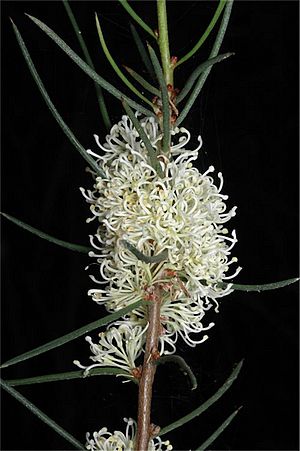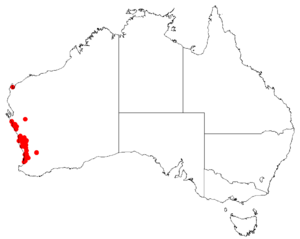Hakea candolleana facts for kids
Quick facts for kids Hakea candolleana |
|
|---|---|
 |
|
| Hakea candolleana in the ANBG | |
| Scientific classification | |
| Genus: |
Hakea
|
| Species: |
candolleana
|
 |
|
| Occurrence data from Australasian Virtual Herbarium | |
The Hakea candolleana is a special type of shrub that belongs to the Proteaceae plant family. You can find it growing along the west coast of Western Australia, especially in areas like the Wheatbelt and Mid West. This plant is known for its pretty cream-white flowers that bloom in winter. It's also great for gardens because it grows low to the ground.
Contents
What Does It Look Like?
The Hakea candolleana is a thick, low-growing shrub. It has many stems and can grow back from a special woody base called a lignotuber. This plant usually reaches a height of about 0.15 to 1.6 metres (0.5 to 5.2 ft). It often spreads out wider than it grows tall.
Its smaller branches are covered in short, soft hairs. These hairs can be white or a rusty color. Sometimes, the branches become smooth and turn a bluish-green color with a powdery look.
Flowers and Leaves
The flowers of Hakea candolleana are very small. They grow in groups of 6 to 8. These flowers are usually white or cream, sometimes with a hint of pink or green. They grow on a tiny stem about 2–3 mm (0.08–0.1 in) long.
The flower stalks are 1.5–4 mm (0.06–0.2 in) long and are white or cream-yellow. They are covered in soft, furry hairs. These flowers have a faint smell and appear between June and August.
The leaves of this plant are flat and long, sometimes looking like needles. They end in a hard, blunt point. Leaves can be different lengths, from 2.5–13 cm (1–5 in) long and 1–4 mm (0.04–0.2 in) wide. Young leaves are hairy, but they become smooth as they get older.
Fruit
After flowering, the plant produces large, "S"-shaped fruits. These fruits are smooth at first, measuring 18–42 mm (0.7–2 in) long and 12–25 mm (0.5–1 in) wide. As they age, their surface becomes rough and pitted. Each fruit ends with a beak-like tip that curves inwards.
How Was It Named?
The Hakea candolleana was first officially described in 1848. This was done by a botanist named Carl Meissner. The plant was named to honor another famous botanist, Augustin Pyramus de Candolle, who was from Switzerland.
Where Does It Grow?
Hakea candolleana likes to grow in open, sunny places. You can find it in areas with heath or shrubland. It grows well in sand, loam, and clay soils. This plant is often found in low-lying areas that can get wet during certain seasons.
It grows from the northern sand plains near the Murchison River down to the city of Perth. There is also a small group of these plants found in Tammin.
Is It Safe?
The government of Western Australia, through its Department of Parks and Wildlife, currently lists Hakea candolleana as "not threatened." This means it is not in danger of disappearing.

